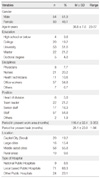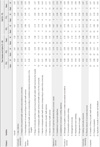Abstract
Purpose
This study was done to assess the educational needs that should be considered in developing curriculum for staff in charge of public health services in public hospitals.
Methods
The participants in this study were staff in charge of public health services in 130 public hospitals. The Borich's Needs Assessment Model which analyzed the relation of 'required competence level' and 'present competence level', was utilized. Data were collected from October to November 2007 using a structure self-report questionnaire. The return rate was 66.9%. The Cronbach's alpha score was 0.959.
Results
The mean scores for 'required competence level', 'present competence level' and Borich's need were 4.02, 3.44, and 2.30 respectively. According to public health service items, 'strategies to recognize the present condition and analyze problems' had the highest score for Borich's need, but 'establishment of annual or monthly objectives' had the lowest score for Borich's need.
Figures and Tables
Table 2
Required Competence Level (RCL), Present Competence Level (PCL) and Educational Needs (Need) Related to Public Health Services

Table 3
Required Competence Level (RCL), Present Competence Level (PCL) and Educational Needs (Need) Related to Public Health Services according to Discipline

References
1. Altschuld JW, Talylor WD, Canelos J. Classifying needs assessment strategies for teaching purposes. Paper presented at the annual meeting of the Evaluation Research Society. 1982, October; Baltimore, Maryland.
2. Bae SS. Public health plan. 2004. Seoul: Kaechukmunhwa-Sa.
3. Baeg JH. Needs assessment of elementary school children for technological literacy contents. 2003. Incheon: Gyeongin National University of Education;Unpublished master's thesis.
4. Borich GD. A needs assessment model for conducting follow-up studies. Journal of Teacher Education. 1980. 31:39–42.
5. Cho DY. Exploring how to set priority in need analysis with survey. Journal of Research in Education. 2009. 35:165–187.
6. Jung JH. The educational needs analysis and design education in practical arts, practical arts curriculum. Journal of Korean Practical Arts Education. 2008. 21:223–240.
7. Kaufman RA. Educational system planning. 1972. Englewood Cliffs, NJ: Prentice-Hall, Inc.
8. Kim JS, Choi YH, Kim SK. Analysis of in-service status and educational needs of engineering faculties. Journal of Engineering Education Research. 2008. 11:50–64.
9. Kim TS, Park YH, Yun TY, Han DU. Relationship between employees' job satisfaction, education demand and intention to leave in health care sector. Paper presented at the meeting of the Korean Society of Health Policy and Administration on Public Health Budgets and Tasks. 2004, November; Seoul.
10. Kim YI, Jung JH, Lee CS, Choi MS. Educational needs analysis of elementary teachers for technological literacy. Journal of Korean Practical Arts Education. 2001. 14:93–107.
11. Kim YL, Kim SW, Chung EK, Choi JS. Education need of the visiting health service workers in Gwangju and Jeollanam-do public health facilities. Korean Journal of Rural Medicine. 2002. 27:51–64.
12. Kister J, Gritzmacher J. Laster JF, Dohner RE, editors. Curriculum research alternatives. Vocational home economics curriculum: State of the field. 1986. Illinois: Bennett & McKnight;136–145.
13. Korea Health Industry Development Institute. Methods to develop the functions of public health. 2001. 11. Seoul: Author.
14. Korea Health Industry Development Institute. A study on the public healthcare plan and evaluation for enhancing public interest in public hospitals. 2006. 04. Seoul: Author.
15. Korea Health Industry Development Institute. The development of the education program for the public health service workforce in public hospitals. 2007. 11. Seoul: Author.
16. Lee JG. Educational needs of elementary school preliminary tea-chers about education contents of 2007 revised practical arts curriculum. Journal of Korean Practical Arts Education. 2009. 22:37–56.
17. Ministry of Health & Welfare. 2nd public health services plan (2006-2010) guideline. 2005. 12. Seoul: Author.
18. Ministry of Health & Welfare. Evaluation of 2006 public health plan & results. 2007. 07. Seoul: Author.
19. Ministry of Health & Welfare. Evaluation of 2008 public health plan & results. 2009. 05. Seoul: Author.
20. Park JH. Strategies for public health service development in the times of local autonomy. Korean Journal of Health Policy and Administration. 2002. 12:1–22.
21. Park NR, Jeong IS, Lee JG, Kim YT, Chun JH, Kim KS, et al. Evaluation of field epidemiology specialist training program based on the satisfaction and the changes of educational needs. Korean Journal of Preventive Medicine. 2004. 37:80–87.
22. Ministry of government legislation. Public Health Act. 2010. Retrieved January 18, 2010. form http://www.law.go.kr/main.html.
23. Strohschein J, Hagler P, May L. Assessing the need for change in clinical education practices. Physical Therapy. 2002. 82:160–172.




 PDF
PDF ePub
ePub Citation
Citation Print
Print





 XML Download
XML Download